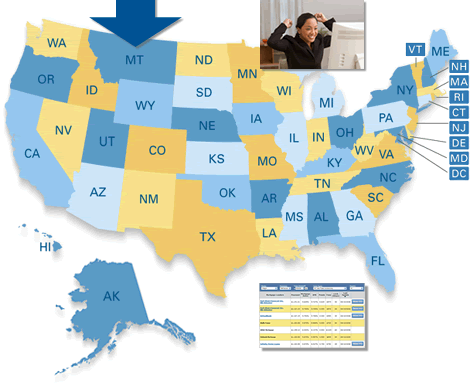Real Estate Market
Dissecting Delinquencies: What the Decline in Delinquencies Means for the Housing Market
by Amy Lillard
(6/20/2012) Last month, news that mortgage delinquencies continued to decline was widely reported. While housing market statistics come out everyday suggesting either the rise or fall of the market, delinquencies are a statistic that provides interesting insight. By looking at delinquencies and the factors at play, we can see the changing face of the housing market as it stands today, and where it might be headed in the future.
In the first quarter of this year, the percentage of homeowners considered delinquent on their mortgages dropped to their lowest level since 2008.
The Mortgage Bankers Association reported that 7.4 percent of borrowers were at least 30 days overdue on their mortgage payments. This was down from 8.3 percent a year ago. In terms of properties, there were a total of 49.5 million outstanding mortgages in March 2012. This was an 11 percent decrease from the peak of more than 55 million in March 2008.
The declines represented in these statistics are dramatic. But even more interesting is breaking down these numbers further. Of all mortgages with delinquent payments, 71 percent are from loans taken out in 2005-2007, before the housing bust when lending standards were looser and prices higher.
Before 2008, mortgage delinquencies were usually less than 2 percent across the country. After the crash, it took a few years for the full effects to be shown in delinquency numbers. The rate of delinquent borrowers peaked at 10.1 percent in the first quarter of 2010.
Why are delinquencies down? Experts point to several complementary forces.
An improving job market seems to be allowing more borrowers to make their payments and pay their bills regularly. The U.S. unemployment rate declined to 8.1 percent in April, the lowest since January 2009.
At the same time, mortgage rates are falling. Over the last few months, rates for 30-year fixed loans have fallen far below the 4.0 percent mark, and continue to set records each week. Newer loans and refinanced loans are cheaper overall, helping borrowers keep affordable payments.
Finally, tighter lending standards are also taking effect. Banks are increasingly extending loans to those who can truly pay, resulting in less defaults and delinquencies.
The delinquency numbers are improving. But experts say they should be even better. What’s keeping them down? A delayed pace of foreclosures, and a slow process.
As a result of the robo-signing scandal that first surfaced in 2010, in which mortgage servicers were accused of fraudulent paperwork used for foreclosure and repossessions, foreclosures have slowed down since the end of 2010. Banks and mortgage providers have been under greater scrutiny, and have responded by dragging out the foreclosure process to ensure all is proper. Some delinquencies have therefore lasted a long time, and keep the totals at a higher level.
Also preventing delinquency rates from improving more is the judicial system. Some states, like Florida and New York, require banks go to court to initiate foreclosure. The process is much more involved and lengthy. In fact, in states requiring court the foreclosure rate is nearly 7 percent, versus 2.8 percent for states that do not require court.
“The problem continues to be the slow-moving judicial foreclosure systems in some of the largest states,” said Michael Fratantoni, MBA's vice president of research and economics, in a statement. “While the rate of foreclosure starts is essentially the same in judicial and non-judicial foreclosure states, the percent of loans in the foreclosure process has reached another all-time high in the judicial states.”
So what’s the outlook? Generally, lower delinquencies is an encouraging sign for the housing market. Combine that with an examination of underwater mortgages and the outlook brightens more.
At first glance, the figures are not encouraging. Over 30 percent of U.S. homeowners with mortgages were underwater in the first quarter of 2012, meaning they owed more than their homes were worth. That accounts for 15.7 million homeowners who owe $1.2 trillion more than their home values.
But what’s interesting is this - despite the numbers of borrowers who are underwater, these borrowers are by and large current on their mortgages. In fact, 9 in 10 are on time with their payments.
Plus, those who are underwater are not deeply so. Nearly 40 percent of those underwater (12.4 percent of all homeowners with mortgages) owe between 1 and 20 percent more than their home value.
"While it was disappointing to see negative equity numbers remain so high, it is important to note that negative equity remains only a paper loss for the vast majority of underwater homeowners," said Zillow Chief Economist Stan Humphries in a statement. "As home values slowly increase and these homeowners continue to pay down their principal, they will surface again."
Overall, the share of first mortgage loans that transition from on-time to 30 days past due is at the lowest level since June 2007. Those transitioning to longer delinquencies is also at record lows.
"[This situation indicates] fewer new problems we will need to deal with in the future,” said Frantantoni.
The combination of falling delinquencies, fewer new delinquencies and a majority of on-time borrowers paint a picture of a housing market growing stronger. And since we are also experiencing record low interest rates and decreased prices, homes are more affordable than ever, making demand grow.
Refinance at Today's Low Rates!
Follow the links to continue reading the related articles
Power of counseling saves struggling homeowners $175 a month
Mortgage delinquencies at lowest level since 2008 or earlier
Mortgage delinquency rate falls for first time in two quarters
Healthy mortgages far outweigh distressed home loans
More homeowners consider strategic defaults, perhaps to their detriment
Fannie Mae & Jumbo Mortgage Rates
Just One Click! = Current Rate Chart


